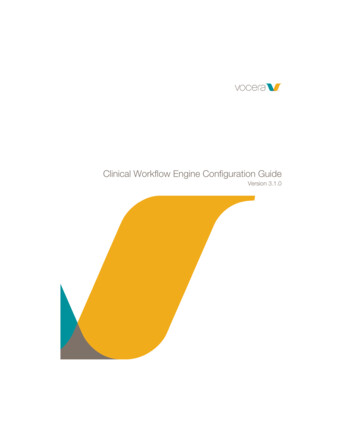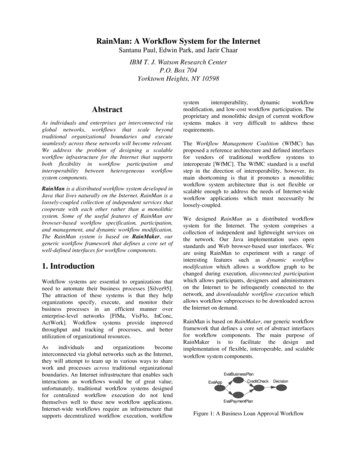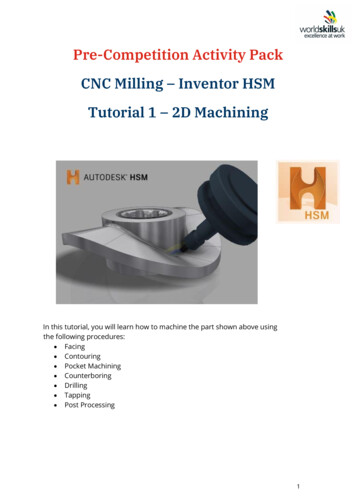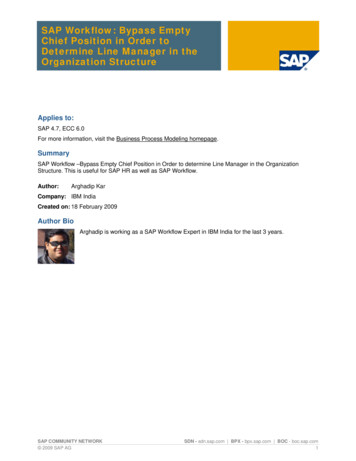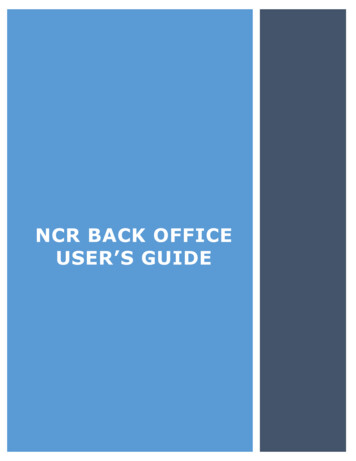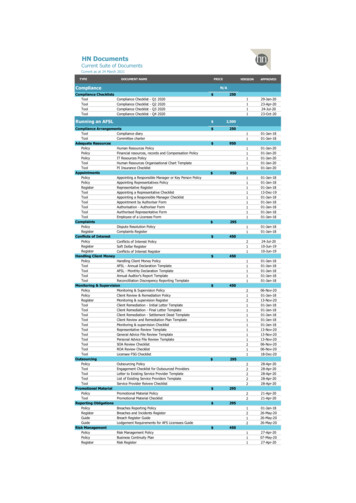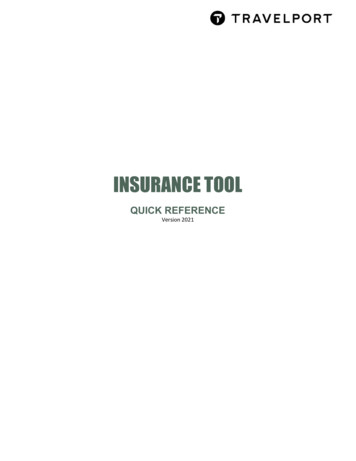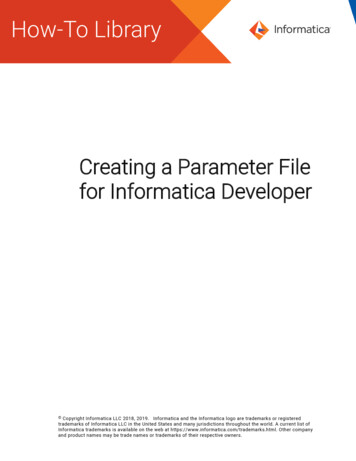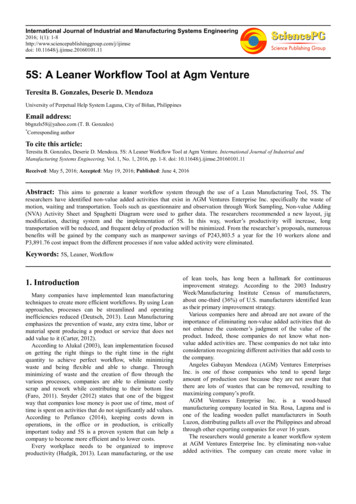
Transcription
International Journal of Industrial and Manufacturing Systems Engineering2016; 1(1): oi: 10.11648/j.ijimse.20160101.115S: A Leaner Workflow Tool at Agm VentureTeresita B. Gonzales, Deserie D. MendozaUniversity of Perpetual Help System Laguna, City of Biñan, PhilippinesEmail address:bbgnzls58@yahoo.com (T. B. Gonzales)*Corresponding authorTo cite this article:Teresita B. Gonzales, Deserie D. Mendoza. 5S: A Leaner Workflow Tool at Agm Venture. International Journal of Industrial andManufacturing Systems Engineering. Vol. 1, No. 1, 2016, pp. 1-8. doi: 10.11648/j.ijimse.20160101.11Received: May 5, 2016; Accepted: May 19, 2016; Published: June 4, 2016Abstract: This aims to generate a leaner workflow system through the use of a Lean Manufacturing Tool, 5S. Theresearchers have identified non-value added activities that exist in AGM Ventures Enterprise Inc. specifically the waste ofmotion, waiting and transportation. Tools such as questionnaire and observation through Work Sampling, Non-value Adding(NVA) Activity Sheet and Spaghetti Diagram were used to gather data. The researchers recommended a new layout, jigmodification, ducting system and the implementation of 5S. In this way, worker’s productivity will increase, longtransportation will be reduced, and frequent delay of production will be minimized. From the researcher’s proposals, numerousbenefits will be gained by the company such as manpower savings of P243,803.5 a year for the 10 workers alone andP3,891.76 cost impact from the different processes if non value added activity were eliminated.Keywords: 5S, Leaner, Workflow1. IntroductionMany companies have implemented lean manufacturingtechniques to create more efficient workflows. By using Leanapproaches, processes can be streamlined and operatinginefficiencies reduced (Deutsch, 2013). Lean Manufacturingemphasizes the prevention of waste, any extra time, labor ormaterial spent producing a product or service that does notadd value to it (Carter, 2012).According to Alukal (2003), lean implementation focusedon getting the right things to the right time in the rightquantity to achieve perfect workflow, while minimizingwaste and being flexible and able to change. Throughminimizing of waste and the creation of flow through thevarious processes, companies are able to eliminate costlyscrap and rework while contributing to their bottom line(Faro, 2011). Snyder (2012) states that one of the biggestway that companies lose money is poor use of time, most oftime is spent on activities that do not significantly add values.According to Pefianco (2014), keeping costs down inoperations, in the office or in production, is criticallyimportant today and 5S is a proven system that can help acompany to become more efficient and to lower costs.Every workplace needs to be organized to improveproductivity (Hudgik, 2013). Lean manufacturing, or the useof lean tools, has long been a hallmark for continuousimprovement strategy. According to the 2003 IndustryWeek/Manufacturing Institute Census of manufacturers,about one-third (36%) of U.S. manufacturers identified leanas their primary improvement strategy.Various companies here and abroad are not aware of theimportance of eliminating non-value added activities that donot enhance the customer’s judgment of the value of theproduct. Indeed, those companies do not know what nonvalue added activities are. These companies do not take intoconsideration recognizing different activities that add costs tothe company.Angeles Gabayan Mendoza (AGM) Ventures EnterprisesInc. is one of those companies who tend to spend largeamount of production cost because they are not aware thatthere are lots of wastes that can be removed, resulting tomaximizing company’s profit.AGM Ventures Enterprise Inc. is a wood-basedmanufacturing company located in Sta. Rosa, Laguna and isone of the leading wooden pallet manufacturers in SouthLuzon, distributing pallets all over the Philippines and abroadthrough other exporting companies for over 16 years.The researchers would generate a leaner workflow systemat AGM Ventures Enterprise Inc. by eliminating non-valueadded activities. The company can create more value in
2Teresita B. Gonzales and Deserie D. Mendoza: 5S: A Leaner Workflow Tool at Agm Venturemanufacturing process by identifying activities that do notdirectly contribute to the products. The focus of the study arethe use of 5S, non-value adding activity sheet and other leanmanufacturing tools to reduce or eliminate direct wastes.Direct wastes results in unproductive work hours foremployees, underutilization of machines and a slowproduction line.The proponents’ area of interest is using 5S as a LeanManufacturing tool, which involves never ending efforts forcontinuous improvement. Thus the researchers conducted aresearch study at AGM Ventures Enterprise Inc. to determinewhat non-value added activities are present and how toreduce, if not eliminate them.According to Koskela (1992), there seems to be three rootcauses why non-value adding activities exist: design,ignorance and the inherent nature of production. Non-valueadding activities exist by design in hierarchical organizations.Every time a task is divided into two subtasks executed bydifferent specialists, non-value adding activities increase:inspecting, moving and waiting. In this way, traditionalorganizational design contributes to an expansion of nonvalue adding activities.Ignorance is another source of non-value adding. Manyprocesses have not been designed in an orderly fashion, butinstead just evolved in an ad hoc fashion to their presentform. The volume of non-value adding activities is notmeasured, so there is no drive to curb them.It is in the nature of production that non-value addingactivities exist: work in process has to be moved from oneconversion to the next, defects emerge, accidents happen.With respect to all three causes for non-value addingactivities, it is possible to eliminate or reduce the amount ofthese activities.Figure 1. Operational Framework.Figure 1 shows the independent variables which are thedirect wastes: transportation, motion and waiting time. Theintervening variables will be the elimination of non-valueadded activities through the use of lean manufacturing tool:5S. Minimizing production costs and the improvement of thecurrent condition of AGM Ventures Enterprise Inc. are thedependent variables which are the results of implementationof 5S.The study will determine the impact 5S as a LeanerWorkflow Tool in eliminating non value added activities atAGM Ventures Enterprise, Inc. Specifically, the study willanswer the following sub-problems:1. What non-value adding activities are currently presentat AGM Ventures Enterprise Inc.?2. What is the cost impact of eliminating non-value addedactivities to AGM Ventures Enterprise Inc.?3. Is there a significant relationship between the existencesof non-value adding activities to the productivity of theworkers at AGM Ventures Enterprise Inc.?The researchers assume that workplace environment is oneof the factors that strengthen employee’s productivity. Sincethey spend huge proportion of their lives at work, it isimportant that they have a good environment to work in. It isassumed that the presence of non-value added activities at thesaid company is due to the excessive motion of workersduring work, poor facility layout and undue transportation.Also, the researchers assume that non-value added activitiesadd expenses to the company. Determining non-value addedactivities present at AGM along with the necessaryinformation, the company will have an improved workflowsystem in order to increase the productivity of the workersand output, as well as to reduce production costs and time.The researchers are guided by this hypothesis: There is nosignificant relationship between the existences of non-valueadding activities to the productivity of the workers at AGMVentures Enterprise Inc.The setting of the study is limited to building 2 of AGMVentures Enterprise Inc., located at Sta. Rosa Laguna,focused on the production of high quality pallets. Pallets thatdo not undergo kiln drying are the only products that theresearchers dealt with. The respondents of the study camefrom the production workers of the 2nd building with a total
International Journal of Industrial and Manufacturing Systems Engineering 2016; 1(1): 1-8number of forty eight (48) production workers. Furthermore,the study only deals with the problems related to eliminationof non-value added activities that is present in the companysuch as waste of transportation, motion and underutilizedworkforce.At the end of the study, the results will benefit thefollowing: the company, the researchers, the institution, thefuture researchers, and it will contribute to the fund ofknowledge in the field of Industrial Engineering. Accordingto Wang (2011), Lean Manufacturing is the production ofgoods using less of everything compared to mass productionand it is focus on reduction of Toyota’s original “sevenwastes” in order to improve overall customer satisfaction.Russel and Taylor (2000) states that waste was defined asanything other than the minimum amount of equipment,materials, parts, space, and time which are absolutelyessential to add value to the product. While for Hirano (2006)waste is everything that is not absolutely essential.Processes that deliver the product or service to thecustomer fall into groups which are value-added activitiesand non-value-added activities. Value-added activities is anactivity that adds value if it is performed in a process that thecustomer is willing to pay for, it is done right the first time,and it transforms the product or service. While non-valueadded activities are those activities that adds unnecessarytime, effort, or cost. (Breyfogle III, 2003).According to Gopalakrishnan (2010), the identification ofnon-value added activities and eliminating them are the coreobjective of lean manufacturing. Managers should havecomplete knowledge of the process from start to end. Theyshould study the process in its totality to identify andeliminate non-value-added activities. While Breyfogle III(2008) states that to help identify waste, the Lean philosophybreaks down waste into seven specific elements which areOverproduction, Inventory, Transportation, Waiting, Motion,Over Processing and Defects.Rahman (2012) defined the waste in transportation, wasteof waiting and waste of movement. Waste in transportation isconcerned with the internal movement of materials on sitewhere poor workplace layout or a lack of process flowcreates many stops and starts in a production cycle. Waste ofwaiting is related to the idle time caused by lack ofsynchronization and leveling of material flows, and pace ofwork by different groups or equipment. Waste of movementis concerned with the unnecessary or inefficient movementsmade by workers during their jobs, which might be caused byinadequate equipment, ineffective work methods, or poorarrangement of the working place.Alvarez (2009) state that implementation of a leanmanufacturing strategy represents a robust contribution to thephase sequence that leads to operational excellence and thecontinuous improvement through the elimination on nonvalue-added activities. On the other hand, Homer Villa,20102 said that "lean" is a business management philosophyand methodology that considers the expenditure of resourcesfor any goal other than the creation of customer value to bewasteful, and thus a target for elimination. Meanwhile,3reviewed studies stated that Lean Manufacturing (wasteselimination) affects positively on reducing the productioncost. These researches provide the manufacturing managerssuitable tools and techniques of eliminating wastes, such as,5S's system, VSM, TPM, and JIT. (Abu Shaaban, 2012).Application of lean principles is one of the best method touse to enhance construction performance in Malaysianconstruction. The successfulness of lean principles inenhancing performance was due to its concept of optimizingand eliminating wastes, rather than minimizing them(Rahman et.al, 2012). In a journal by Kumar, C. and Kumar,P., it is stated that Lean manufacturing is a systematicapproach to identifying and eliminating wastes (non-valueadded activities) through continuous improvement byconveying the product at the pull of the customer in pursuitof production. From the discussion of related literatures andstudies, the researchers found out that there was no study thathad been conducted on generating a leaner workflow systemat AGM Ventures Enterprise Inc.2. MethodologyThe instruments used to collect data are observation,interview and questionnaire. Informal observation andinterview was also conducted during data collection forvalidation purposes. Work sampling is a method in which alarge number of instantaneous observations are made atrandom time intervals over a period of time on a group ofmachines, workers or processes/operations. In this study,work sampling was used whether a worker has beenultimately utilized or underutilized. It is where theresearchers will also identify how much cost a companyspends in a worker who is not efficient and productive.Non Value-Adding (NVA) Activity Sheet was used todetermine the non-value added activities that are present inthe company. Spaghetti Diagram which is a Lean Six Sigmatool was used to expose inefficient process layouts,unnecessary travel distance between process steps andoverall process waste.AGM Ventures Enterprise Incorporated has a total of onehundred twenty nine (129) employees, wherein seventeen(17) are the management staff and one hundred twelve (112)are the production workers. The researchers will only dealwith the 2nd building of the company since the focus of thestudy are pallets not undergoing kiln drying are done in thisbuilding. This building has 48 workers and the researcherdecided to use only 20% as sample respondent equivalent to10 workers. Percentage and Coefficient of Correlation wereused to determine the relationship of non-value addedactivities and productivity of workers.3. Results and DiscussionIt is through observation that the researchers were able todetermine various NVA activities present at AGM. Table 1shows Work Sampling results from the 10 workers.
4Teresita B. Gonzales and Deserie D. Mendoza: 5S: A Leaner Workflow Tool at Agm VentureTable 1. Summary of Percent Idle.Sample RespondentsWorker 1Worker 2Worker 3Worker 4Worker 5Worker 6Worker 7Worker 8Worker 9Worker 10Total No. of Observation125125125125125125125125125125Total No. of Working76737368718277747569Total No. of Idle29323237342528313036% 513109672Actual work sampling result done by the researchers can be found in Appendix A. Table 1, shows the summary of idlesgathered from the 10 workers for 5 days. Worker 4 has the highest percent idle (29.6%) and worker 6 has the least percent idle(20%). Average percent idle form the 10 workers is 25.12% or equivalent to 2 hours (120.576 min).Table 2. Reasons of Idle Time per Worker.WORKER REASONSTalking during workingTextingEarly BreakWalking not related to workWaiting for Jack L5533638776314%17.510.52027.724.2100RANK45312As evidenced by Table 2, walking ranked 1st, 87 out of 314 or equivalent to 27.7% of the total idle and the least is texting, 33out of 314 or equivalent to 10.5% only.Figure 2. AGM Current Layout with Spaghetti Diagram.
International Journal of Industrial and Manufacturing Systems Engineering 2016; 1(1): 1-8The current layout of AGM (is shown in Appendix C) isone of the causes of the poor production flow whichgenerates costs to the company. As observed from the currentsituation, long transportation exists. Poor layout has been oneof the causes of having excessive transportation that adds tothe non-value added activities of a worker. Barriers to theroute of transportation are also a cause of delay during thetransportation process of raw materials, Work in Process(WIP) and finished goods. There is also insufficient space forthe mobilization of forklift and jack pallets. They are havingdifficulties in terms of the access to pathways due to theobstructions on their way. The foam stock room is also notutilized. The access of the way in transporting materials frompre-assembly area to assembly area is one of the causes oflong transportation in AGM. The workers need to go onfar/long distance to make it to the assembly area since theyhave placed the logs in these areas for them to create theirown place for rest. Waste of transportation causes thecompany to spend money at an alarming rate which alsogives many opportunities for handling damage and losses.Details of the survey are shown in Appendix E, on theaverage, 7 out of 10 respondents answered that they canfinish 51-70 pieces of pallets a day; while 3 out of 10answered they are capable of finishing 30-50 pallets a day.As to enough space to transfer raw materials from one placeto another, 1 out of 10 answered that their space is veryadequate, 2 for adequate, 1 for fairly adequate and 6 forinadequate. By the term inadequate, this means that the spacefor transportation is not enough for the mobilization of jackpallets and forklift. Availability of forklifts and jack pallets totransfer goods shows that 1 out10 answered very adequate, 2out of 10 for adequate and fairly adequate and 5 out of 10 forinadequate. This only shows that there is not enough numberof jack pallets and forklift to use in the production area. As toaccess to pathways to transfer raw materials, work in processand finished goods, 2 out of 10 respondents answered veryadequate, 1 out of 10 for adequate and fairly adequaterespectively, 4 out of 10 for inadequate and 2 out of 10 forvery inadequate. This shows that there is not enough accessfor transportation of raw materials, work in process andfinished goods. In searching for tools, equipment and evenraw materials to be used, 6 out of 10 respondents answeredthat they search for tools, equipment and materials veryoften, 3 out of 10 for often, and 1 out of 10 for fairly often.As to the barriers to the route of transferring raw materials,work in process and finished goods, 9 out of 10 respondentsanswered yes, while only 1 out of 10 answered that there isnone. Barriers like scattered scraps of the different parts of apallet, unorganized arrangement or stacking of the pallets andnarrow pathways for transportation.Having idled in work is a waste, and has a big impact tothe company. AGM Ventures Enterprise Inc. pays theworkers in right amount which in return the worker shouldendeavor themselves in doing the job well without wastingevery second and make sure that the product is on its bestcondition. The actual collected data gathered using NVA5activity sheet can be found in Appendix B. Table 3 shows theaverage NVA activity in minutes and the output producedwith the NVA activity present.Table 3. Breakdown of NVA activity per Process with corresponding Output.BAND SAWTRIALS (min)NVA activity123Searching for log to be used 8.156.2210.01 7.355.66Set-up jigs to desired length 121.211.1610.66 9.6712.79.9710.16 10.6327983728087Set-up jigs to the machine1.210.540.770.931.16Removing the scrap fromthe 271.866Output496554625658PLAINERTalking during workingtimeRemoving the scrap fromthe ng the 0.230.580.340.180.110.250.140.180.10.26Talking during workingtimeStacking processed log tojack ng during workingtimeWaiting for jack pallet totransport the finishedproduct to the storage areaPOLISHINGTalking during workingtimeWaiting for jack pallet totransport the finishedproduct to the storage areaCleaning the 1.211.302Output362431283631Table 3 presents the NVA activity incurred per processwith their corresponding output when observed using NVAactivity sheet 5 times. Band Saw has the highest averageNVA activity of 10.632min. and the least is Jointer processwith 0.538min.only.
6Teresita B. Gonzales and Deserie D. Mendoza: 5S: A Leaner Workflow Tool at Agm VentureTable 4. Cost Impact of NVA per Process.Band Saw ProcessCutter ProcessPlainer ProcessJointer ProcessAssemblyPolishing ProcessTOTALAverage NVA Activities (min)10.6321.8662.4020.5381.3021.30218.042Cost Benefit per DayP7.9631.3981.7990.4030.9750.97513.513In computing the cost benefit of the excessive motionshown in Table 4 of each worker per process, the researchersmultiply the total NVA activities by the daily rate which costsP337. The company will save P3891.76 per year if nonvalue-added activities are eliminated.Computation of Manpower Savings per Process:Rate per day P337 this is from 8am to 5pm or 540minActual working hours is 540min less break time of 90 minCost Benefit per MonthP191.11233.55243.1769.67223.423.4324.312Cost Benefit per 6 450minRate per min P337/450 P0.749 per min.Band Saw: (P0.749min) (10.632min) P7.963 per day(P7.963/day) (24days) P191.112 per month(P191.112/month) (12months) P2,293.344 per yearNote: Cost benefit per year for other processes werecomputed the same way.Table 5. Cost Impact of Percent Idle.Name of WorkerWorker 1Worker 2Worker 3Worker 4Worker 5Worker 6Worker 7Worker 8Worker 9Worker 10TotalPercent Cost Benefit Per DayP 78.18P 86.27P 86.27P 99.75P 91.66P 67.40P 75.49P 83.58P 80.88P 97.06P 846.54Table 5 showed the manpower savings of AGM VenturesEnterprise Inc. for the ten workers. Manpower savings iscomputed by multiplying the daily rate of the workers by thepercent idle. If the NVA activities were eliminated throughthe strict implementation then, the company will saveP243,803.5 yearly just for the 10 workers.Computation of Manpower SavingsRate/day P337Working days/month 24Months/year 12Worker 1: (23.20%) (P337) P78.18/day(P78.184/day) (24days) P1,876.32/month(P1876.416/month) (12months) P22,515.84/yearNote: Computation for other workers in terms of costbenefit per year were computed the same way.Computation as to the significant relationship of thepresence of NVA activities and the productivity of productionworkers in each process, using coefficient of correlation canbe seen in Appendix C. To sum up the results based on thecomputed data, the existence of different kinds of waste hasno effect/impact on productivity. This is so because incomputing the output of the worker the researcher focus onthe actual processes in making the product and other NVAactivity such as texting and early break were not seen duringthese times.Cost Benefit Per MonthP 1,876.32P 2,070.48P 2,070.48P 2,394.00P 2,199.84P 1,617.60P 1,811.76P 2,005.92P 1,941.12P 2,329.44P 20,316.96Cost Benefit Per YearP 22,515.84P 24,845.76P 24,845.76P 28,728.00P 26,398.08P 19,411.20P 21,741.12P 24,071.04P 23,293.44P 27,953.28P 243,803.54. ConclusionBased on observation conducted by the researchers atAGM, direct wastes are identified. It is through the use ofsome lean manufacturing tools that the observation cited aresupported. With the percent idle ranging from 20% - 29.6%through the use of work sampling, it is undoubtable that thewaste of underutilized workforce exists. In the application ofnon-value adding activity sheet in gathering data, waste ofmotion and delay is observed due to the searching of logs tobe processed in band saw, frequent cleaning of theirworkplace and waiting of transfering equipments. Theresearchers have also analyzed the current layout of the saidcompany with the use of spaghetti diagram. Excessivetransportation was scrutinized beacuse of the obstructions inthe access of ways and the poor layout of the company thatcauses rough production flow and delay in producing thegoods.From the computed findings through work sampling,AGM Vantures can save up to P243,803.5 per year for ten(10) workers and P3,891.76 cost impact from the differentprocesses. Through the use of coefficient of correlation, it isproved and concluded that there is no significant relationshipbetween NVA activities and the productivity of the workers.
International Journal of Industrial and Manufacturing Systems Engineering 2016; 1(1): 1-85. Direction for Future Use5S is a team-based activity where everyone works toimprove the conditions on a specific area. A clean and wellorganized workplace provides a foundation for: a goodcompany image bringing more business, improving worker’smorale removing frustrations, improving quality, eliminatingwastes, safer workplace, cost reduction, and better efficiency.A 5S Audit checklist – workplace evaluation, as shown inthe Appendices F may be implemented by the managementin every production line. Each day, the supervisors will checkand rate the workplace of every lines, whoever line got thehighest points at the end of the month will be rewarded. Withthis implementation, workers will be encouraged to organizetheir workplace.The objective of the proposed layout is to reduce7materials-handling costs, allow space for productionmachines, provide for volume and product flexibility, providefor employee safety and health, allow ease of supervision,allow ease of maintenance and achieve objectives with leastcapital investment. Access to pathways has given spaciousarea in order for them to fully mobilize the transferringequipment without any obstruction or difficulties. Themachineries or equipment are arranged to ensure continuousflow of material in an orderly mode throughout the plant. Thefoam stock room was eliminated since it is no longer utilized.Since the layout corresponds to the sequence of operations,smooth and logical flow lines can result. The work from oneprocess is fed directly into the next. Total production time perunit is shortened. The machines are located in order tominimize distances between consecutive operations, materialhandling will reduce.Figure 3. Proposed Layout.On the band saw and cutter machines, wood jigs were notfixed on the machine resulting to workers to constantly adjustit to its required measurement. Bad thing if wood jigs werenot precisely aligned. For this reason, the researchersrecommend to have Jig Modification/ Machine modification.This will modify machines to set jigs to be fixed. In this way,workers can continuously work without bothering theadjustments of jigs, and delay with this process will beeliminated.In the production area, particular to Building 2, with theprocesses of band saw, cutter, plainer, and jointer, cleanlinesscannot be maintained through installation of a machine thatautomatically sack in and out the saw dust wood residues outof the work area to eliminate frequent cleaning that adds to thenon-value added activities of the company. Workers are unableto work productively if their workplace was too untidy, thus,they keep on sweeping the scraps mounted on their place. Thiscondition causes process delay. With the implementation of aDucting System, constant cleaning which is a NVA activitymay be eliminated or if not, it can be reduced.
8Teresita B. Gonzales and Deserie D. Mendoza: 5S: A Leaner Workflow Tool at Agm VentureReferences[1]Alukal, G. Create a lean, mean machine. Quality Progess,2003.[2]Abu Shaaban, Mohammed Sufian. Wastes Elimination as theFirst Step for Lean Manufacturing An Empirical Study forGaza Strip Manufacturing Firms. Published or University ofGaza Deanery of Higher Studies, 2012.[14] 9c(August 15, 2014)[15] -bestpractice-processes/ (Date retrieved: August 30, 2014)[16] roductionlean manufacturing.html (Date retrieved: August 30, 2014)[17] or-success(Date retrieved: August 30, 2014)[3]Gopalakrishan N. Simplified Lean Manufacture: Elements,Rules, Tools and Implementation, 2010.[18] ntagethrough-5s/ (Date retrieved: August 30, 2014)[4]HungLin, Chi. 5S implementation in Wan Cheng IndustryManufacturing Factory in Taiwan. (Unpublished Master’sThesis, University of Wisconsin-Stout, May 2011).[19] ointsimportant-for-managing-a-5s-process/ (Date retrieved: August30, 2014)[5]Koskela, Lauri. 1992. Application of the New ProductionPhilosophy to Construction. Technical Report, Center forIntegrated Facility Engineering. Department of CivilEngineering. Stanford University[20] 0IEDPDM0 (Date retrieved: August 31, 2014)[6]Kumar, Chakrabortty and Kumar, Paul. Study andImplementation of Lean Manufacturing in a GarmentManufacturing Company: Bangladesh Perspective, 2010.[7]Rahman, Hamzah Abdul., Wang, Chen., Lim, Irene Yen Wui.Waste Processing Framework For Non-Value AddingActivities Using Lean Construction, 2012.[8]Russell, R.S. and Taylor, B.W. Operations Management,Prentice-Hall, Englewood Cliffs, NJ, 2000. Santos, Javier.,Wysk, Richar., Torres, Jose. Improving Production with LeanThinking. John Wiley & Sons, Inc., 2006.[9]Singh, A. and Singh, H. Implementation of a CellularManufacturing Tool for Minimization of Non Value AddedActivities. Amanparteek Singh Int. Journal of EngineeringResearch and Applications, 2014.[10] Wang, John X. Lean Manufacturing Business Bottom-LineBased, 201.[11] ssimprovement-basics (August 15, 2014)[12] http://www.
2 Teresita B. Gonzales and Deserie D. Mendoza: 5S: A Leaner Workflow Tool at Agm Venture manufacturing process by identifying activities that do not directly contribute to the products. The focus of the study are the use of 5S, non-value adding activity sheet and other lean manufact
